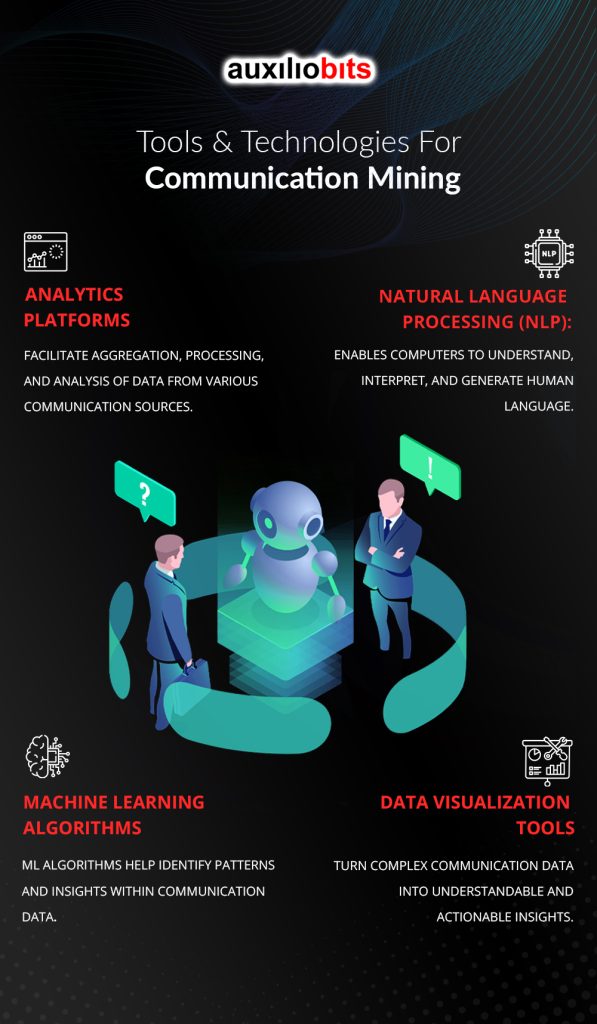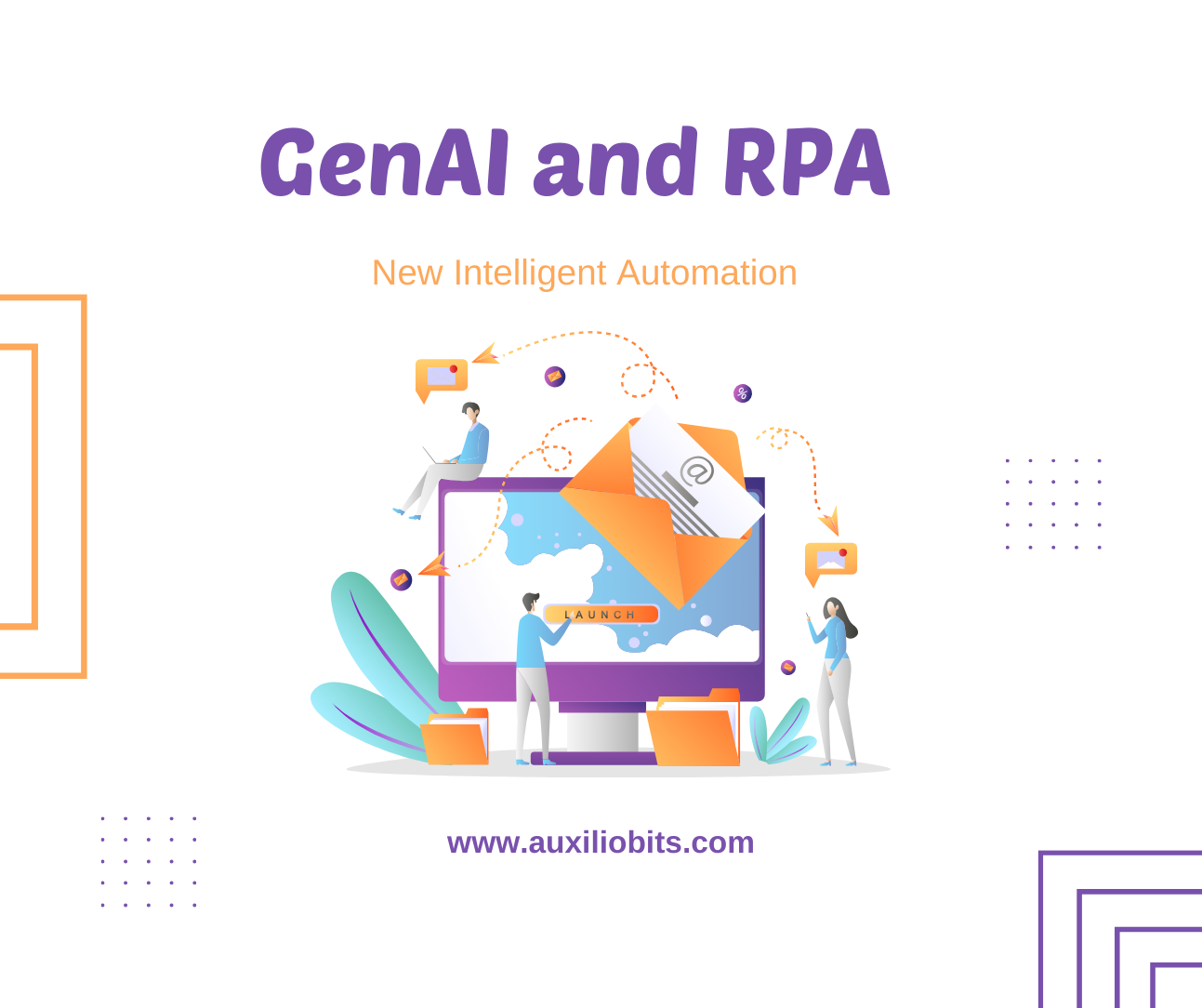Key takeways
- Communication mining is a transformative approach to harnessing the power of data and analytics to maximize your business potential.
- Communication Mining is the process of systematically analyzing communication data to extract valuable information and insights.
- Communication mining is a strategic asset that helps you understand your stakeholders and facilitates innovation.
- Communication mining streamlines operations, enhances decision-making, and boost customer experience.
- Data is mined from external and internal communication channels to provide valuable insights.
- Communication mining leverages technologies like AI, ML, NLP, Data Visualization, and Data Analytics.
- Communication mining is evolving as it integrates new technologies.
Effective communication is at the heart of successful business operations in this increasingly data-driven world. However, it’s not just about exchanging messages or words, it’s about mining the valuable insights that lie within your communication data. Here, let’s learn more about communication mining – a transformative approach to harnessing the power of data and analytics to maximize your business potential.
- The Significance Of Communication In Business
- Understanding Communication Mining
- Benefits Of Communication Mining
- Data Sources For Communication Mining
- Tools & Technologies For Communication Mining
- Applying Communication Mining In Your Business
- Overcoming Communication Mining Challenges
- The Future Of Communication Mining
- Conclusion
The Significance Of Communication In Business
Communication is the lifeblood of any organization. According to a study, companies with effective communication are 50% more likely to have lower employee turnover rates & higher customer satisfaction scores. (Source: Mvix Digital Signage)
It’s not just about getting your message across, it’s about listening, understanding & making data-driven decisions. This blog explores how businesses can leverage communication data for competitive advantage.
Understanding Communication Mining
Defining Communication Mining
Communication Mining is the process of systematically analyzing communication data to extract valuable information and insights. It goes beyond merely reading messages, it’s about translating the language of business into actionable knowledge. To put this into perspective, consider that a study by IBM found that over 2.5 quintillion bytes of data are created every day, with a significant portion of it being communication data.
The Role Of Communication Data
- Data as a Strategic Asset
Think of your communication data as a strategic asset. In today’s digital age, it’s no longer just the content of your messages, it’s a valuable source of insights that can be leveraged to gain a competitive edge. According to a report by McKinsey, data-driven organizations are six times as likely to retain customers and 19 times more likely to be profitable!
(Source: Keboola)
- Understanding Your Stakeholders
Your communication data is a mirror reflecting the relationships your business has with stakeholders. By mining this data, you gain an in-depth understanding of your customers, employees, and partners. A study by PwC found that 73% of companies that use data to understand their customers have seen significant improvements in their customer relationships.
(Source: Textexpander, PWC)
- Innovation & Problem-Solving
Your communication data contains not only the questions and answers but also the insights and challenges. By analyzing it, you can identify recurring issues, anticipate customer needs, and foster innovation. Google’s “Project Aristotle”, for example, used communication data to discover the key attributes of successful teams.
(Source: New York Times)
Benefits Of Communication Mining
Enhanced Decision-Making
Communication Mining can help you make data-driven decisions. By analyzing historical communication data, businesses can better understand market trends, customer preferences, and employee performance. This insight can lead to informed strategies that align with your goals.
Improved Customer Relations
A study by Salesforce revealed that 75% of customers expect a consistent experience wherever they engage with a brand. Communication Mining can help you maintain consistency by understanding customer preferences and providing personalized experiences.
(Source: Salesforce)
Streamlined Operations
Efficiency is essential for any business. Analyzing internal communication data can help identify bottlenecks, streamline processes, and reduce operational costs. Businesses using effective internal communication tools are 3.5 times more likely to have much better results.
(Source: Brosix)
Data Sources For Communication Mining
Internal Communication Channels
Internal communication channels are at the core of your organization’s functioning. Emails, chat logs, instant messages, and internal social platforms provide a rich source of data that can offer insights into employee interactions and operations. According to a report, in 2022, the average office worker received 121 emails per day. That’s a vast amount of data!
(Source: Campaign Monitor; Expanded Ramblings)
By analyzing internal communication, you can:
- Enhance Employee Engagement
Research by Gallup shows that engaged employees are 18% more productive. Communication mining can help you identify engagement trends and improve internal communications accordingly.
(Source: Gallup)
- Streamline Processes
Teams who communicate effectively in the workplace may see as much as a 25% increase in their productivity & reduce time spent on unnecessary tasks.
(Source: Apollo Technical)
Understanding where communication bottlenecks occur can help streamline your processes.
External Communication Channels
Your interactions with customers, suppliers, and partners through external communication channels are an equally critical source of data. These channels encompass customer emails, calls, support tickets, and more. 88% of customers say interaction & experience matters as much as products, according to Salesforce’s State of the Connected Customer report.
[https://www.salesforce.com/content/dam/web/it_it/www/pdf/connected-customer-report-2020.pdf]
This highlights the growing importance of external communication data.
By analyzing external communication, you can drive revenue growth. Analyzing customer interactions can lead to significant revenue growth. A study by Bain & Company found that companies that excel at customer experience grow revenues 4-8% above their market.
Harnessing Social Media Data
Social media has become a powerful force in shaping brand perceptions and customer sentiments. Platforms like Facebook, Twitter, LinkedIn, and Instagram generate an enormous amount of social media data. In 2022, the number of social media users worldwide reached 4.59 billion, which is expected to increase to almost 6 billion in 2027. This makes social media an incredibly rich source of communication data.
(Source: Statista)
By harnessing social media data, you can track trends and emerging Issues. Social media data can help you identify trends and emerging issues in real time. For instance, a report by Brandwatch showed that 96% of social media users discuss brands on social networks.
Tools & Technologies For Communication Mining
Analytics Platforms
Analytics platforms are the backbone of Communication Mining. These platforms enable you to aggregate, process, and analyze data from various communication sources. According to a report by IDC, global spending on big data and analytics solutions is expected to reach $215.7 billion by 2022, highlighting the growing importance of analytics in business.
(Source: Business Wire)

Natural Language Processing (NLP)
Natural Language Processing (NLP) is a critical technology for Communication Mining, especially when dealing with unstructured text data. NLP helps computers to comprehend, interpret, and generate human language. The global NLP market is projected to reach $80.68 billion by 2026.
(Source: PR News Wire)
Machine Learning Algorithms
Machine learning algorithms play a pivotal role in identifying patterns and insights within your communication data. The global machine-learning market is expected to grow to $96.7 billion by 2025.
(Source: PR News Wire)
Data Visualization Tools
Data visualization tools are essential for turning complex communication data into understandable and actionable insights. The data visualization market is projected to reach $10.2 billion by 2026.
(Source: Global News Wire)
Applying Communication Mining In Your Business
Identifying Key Metrics
Key metrics act as a compass, guiding your analysis and ensuring that you focus on what matters most. Research says that organizations that define metrics and measure their performance see an improvement in their strategic alignment. Key metrics can include:
- Customer Acquisition Cost (CAC)
It refers to the expenses incurred for acquiring a new customer.
- Customer Lifetime Value (CLV)
Refers to the total revenue generation expected from a customer over their lifetime.
- Churn Rate
What percentage of customers stop using your products or services?
- Net Promoter Score (NPS)
It is an indicator of customer loyalty and satisfaction.
Predictive Analytics For Market Insights
One of the most powerful applications of Communication Mining is predictive analytics. This involves using historical data to make informed predictions about future trends. A report by Research and Markets suggests that the predictive analytics market is expected to reach $14.9 billion by 2026.
(Source: Business Wire)
Competitive Intelligence
Your competitors are also engaging in communication that can yield valuable insights. Competitive intelligence through Communication Mining involves monitoring and analyzing your competitors’ communication data. According to MarketsandMarkets, the competitive intelligence market is expected to reach $20.4 billion by 2028.
(Source: Markets And Markets)
Overcoming Challenges
Data Privacy
Data privacy concerns are at the forefront of any data-driven initiative. Gathering & analyzing communication data must be done in a way that respects individual privacy & complies with relevant regulations. The GDPR (General Data Protection Regulation) in Europe & the CCPA (California Consumer Privacy Act) in the United States are just two examples of stringent data privacy regulations.
As of 2022, 81% of customers are more concerned about how their data is used and shared than they were a few years ago.
(Source: Social Media Today)
To overcome this challenge, businesses should:
- Establish clear data privacy policies and procedures.
- Obtain proper consent for data collection and use.
- Protect individual identities by anonymizing and aggregating data.
- Continuously monitor and ensure compliance with data privacy regulations.
Handling Big Data
Challenge: Data Volume
The sheer volume of communication data can be overwhelming. Handling big data efficiently requires the right infrastructure and tools. “By 2025, the amount of data generated each day is expected to reach 463 exabytes globally.”
(Source: Haslam College Of Business)
To overcome this challenge, businesses should:
- Invest in robust data storage and processing capabilities.
- Leverage cloud-based solutions for scalability.
- Implement data retention policies to manage data volume effectively.
The Future Of Communication Mining
Emerging Trends
Trend 1: Conversational Analytics
The future of Communication Mining lies in conversational analytics. This approach goes beyond text-based analysis and delves into voice interactions, including customer service calls and virtual assistant conversations. By 2030, the global conversational analytics market is projected to reach $43.7 billion. Analyzing these interactions can provide deeper insights into customer behavior and preferences.
(Source: Global News Wire)
Trend 2: Multi-Channel Integration
As customers interact with businesses across multiple channels, Communication Mining will evolve to integrate and analyze data from various sources seamlessly. Multi-channel integration allows organizations to gain a holistic view of customer interactions. A report by Aberdeen Group suggests that companies with strong multi-channel engagement retain 89% of their customers, compared to 33% for those without.
(Source: Porch Group Media)
Role of AI
The future of Communication Mining is intrinsically tied to Artificial Intelligence (AI). AI-powered algorithms will become even more sophisticated, enabling organizations to automate tasks, such as sentiment analysis & chatbot responses. Data reveals that the global AI market is likely to reach $190.6 billion by 2025.
(Source: PR News Wire)
Conclusion
In a world characterized by data-driven decision-making, effective Communication Mining has emerged as a powerful tool for businesses to not only thrive but also stay ahead in the ever-competitive marketplace. It is not just a modern trend, it’s a strategic imperative for businesses of all sizes. The ability to harness communication data, whether internal or external, and transform it into actionable insights provides a significant competitive advantage.
The future is bright for Communication Mining, but it also presents new challenges and opportunities. To ensure your business remains at the forefront of this transformative journey, embrace emerging trends, leverage AI and automation, and prioritize data privacy and ethics.
Do you want to leverage the power of communication mining to boost your business?
Then connect with the experts at Auxiliobits!




 July 19, 2024
July 19, 2024
